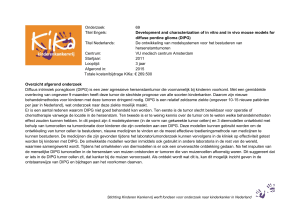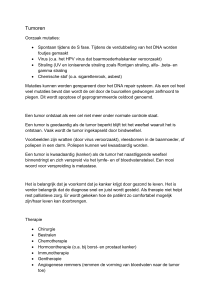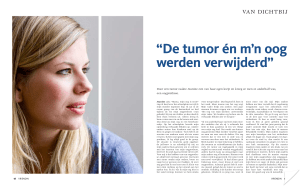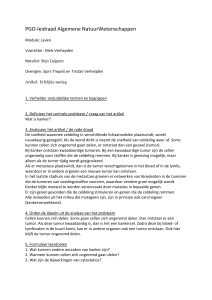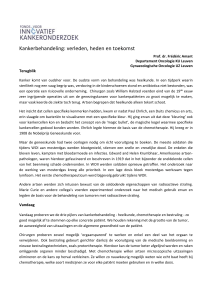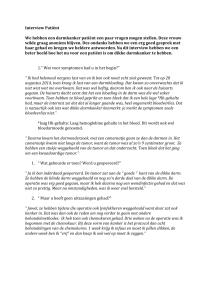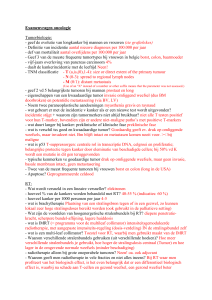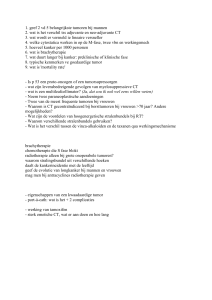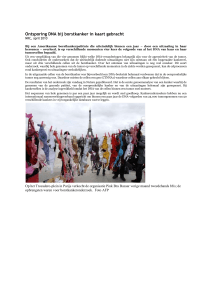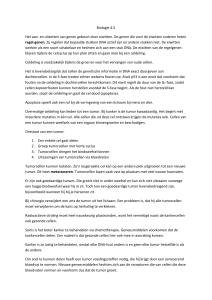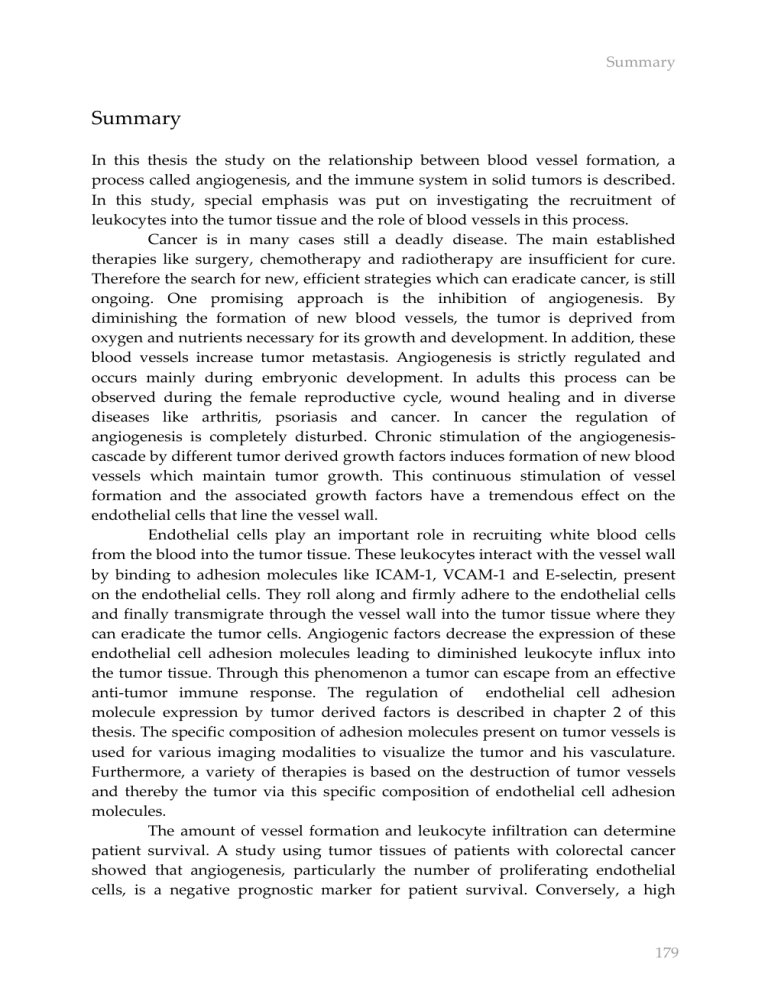
Summary Summary In this thesis the study on the relationship between blood vessel formation, a process called angiogenesis, and the immune system in solid tumors is described. In this study, special emphasis was put on investigating the recruitment of leukocytes into the tumor tissue and the role of blood vessels in this process. Cancer is in many cases still a deadly disease. The main established therapies like surgery, chemotherapy and radiotherapy are insufficient for cure. Therefore the search for new, efficient strategies which can eradicate cancer, is still ongoing. One promising approach is the inhibition of angiogenesis. By diminishing the formation of new blood vessels, the tumor is deprived from oxygen and nutrients necessary for its growth and development. In addition, these blood vessels increase tumor metastasis. Angiogenesis is strictly regulated and occurs mainly during embryonic development. In adults this process can be observed during the female reproductive cycle, wound healing and in diverse diseases like arthritis, psoriasis and cancer. In cancer the regulation of angiogenesis is completely disturbed. Chronic stimulation of the angiogenesis‐
cascade by different tumor derived growth factors induces formation of new blood vessels which maintain tumor growth. This continuous stimulation of vessel formation and the associated growth factors have a tremendous effect on the endothelial cells that line the vessel wall. Endothelial cells play an important role in recruiting white blood cells from the blood into the tumor tissue. These leukocytes interact with the vessel wall by binding to adhesion molecules like ICAM‐1, VCAM‐1 and E‐selectin, present on the endothelial cells. They roll along and firmly adhere to the endothelial cells and finally transmigrate through the vessel wall into the tumor tissue where they can eradicate the tumor cells. Angiogenic factors decrease the expression of these endothelial cell adhesion molecules leading to diminished leukocyte influx into the tumor tissue. Through this phenomenon a tumor can escape from an effective anti‐tumor immune response. The regulation of endothelial cell adhesion molecule expression by tumor derived factors is described in chapter 2 of this thesis. The specific composition of adhesion molecules present on tumor vessels is used for various imaging modalities to visualize the tumor and his vasculature. Furthermore, a variety of therapies is based on the destruction of tumor vessels and thereby the tumor via this specific composition of endothelial cell adhesion molecules. The amount of vessel formation and leukocyte infiltration can determine patient survival. A study using tumor tissues of patients with colorectal cancer showed that angiogenesis, particularly the number of proliferating endothelial cells, is a negative prognostic marker for patient survival. Conversely, a high 179 Summary number of white blood cells in the tumor tissue has very often a positive effect on survival of cancer patients (chapter 3). These results indicate that inhibition of angiogenesis and accompanying stimulation of leukocyte infiltration in the tumor, is a potential strategy to treat people with cancer. Experiments in mouse tumor models demonstrated that angiogenesis inhibition is associated with the normalization of adhesion molecule expression on tumor endothelial cells. This increase consequently leads to enhanced leukocyte‐
vessel wall interactions and an induction of leukocyte influx in the tumor tissue (chapter 4 and 5). Treatment of human endothelial cells with angiogenesis inhibitors induces a similar increase of adhesion molecule expression and leukocyte adhesion on activated endothelial cells. The increase of white blood cells in the tumor tissue after angiostatic treatment does not confine to one specific subtype of cells. The number of activated leukocytes in the tumor is significantly up‐regulated upon treatment with angiogenesis inhibitors. Immunosuppressive cells like regulatory T cells which suppress the anti‐tumor immune response, were found not to be preferentially attracted. We can conclude from these data that angiogenesis inhibitory treatment of tumors reduces tumor growth not only by diminishing vessel formation but also by stimulating the specific anti‐tumor immune response (chapter 5). This concept supports the hypothesis that cancer can be more efficiently treated by combining anti‐angiogenesis and immunotherapy. The mechanism behind this restoration of endothelial cell adhesion molecule expression on tumor vessels by angiostatic therapy can partially be explained by epigenetic processes. Promotor histone modifications suppress the expression of ICAM‐1 in tumor (‐conditioned) endothelial cells in vitro and in vivo. DNA methyltrasferase‐ and histone deacetylase inhibitors, capable to eradicate angiogenesis, are able to reactivate the expression of ICAM‐1 on tumor endothelial cells and stimulate leukocyte‐vessel wall interactions (chapter 6). The search for a suitable immunotherapy to use in combination with our angiogenesis inhibitors led to the cytokine interleukin‐21. This cytokine has been successfully used in different mouse tumor models and is now being tested in phase I clinical trails. Interleukins are known to be able to affect angiogenesis, positively as well as negatively. The effect of IL‐21 on tumor angiogenesis is important information if this cytokine is to be used in combination with angiogenesis inhibitors in cancer treatment. In vitro and in vivo experiments demonstrated that IL‐21 can inhibit angiogenesis. This inhibition is associated with the reduced activation of signal transducer and activator of transcription 3 (Stat3) and declined expression of angiogenic factors/receptors. By combining angiostatic and immunostimulatory properties, IL‐21 may be a future powerful soldier in the battle against cancer (chapter 7). 180 Summary The above‐mentioned studies mainly discuss the regulation of the most familiar adhesion molecules expressed by tumor endothelial cells like ICAM‐1, VCAM‐1 and E‐selectin which mediate leukocyte‐vessel wall interactions. However, other, more recently described and less studied molecules exist that are implicated in leukocyte recruitment to the tumor tissue as well. Vascular adhesion protein 1 (VAP‐1) is such a molecule. In vivo experiments show that VAP‐1 is involved in both rolling and adhesion of leukocytes to the tumor vessel wall. In addition, the number of VAP‐1 positive vessels is not affected by angiogenic factors which is in contrast to the effects on ICAM‐1 expression (chapter 8). The results described in this thesis demonstrate a strong relationship between angiogenesis and the immune response in a tumor. Inhibition of tumor angiogenesis, simultaneously leads to induction of the anti‐tumor immune response. IL‐21, a cytokine known for its immune regulatory and immunotherapeutic capacities, can inhibit angiogenesis as well. This thesis shows that the combination of angiogenesis inhibition and immunotherapy can be a new break‐through in the search for new strategies to fight cancer. 181 Summary 182 Samenvatting Samenvatting In dit proefschrift wordt de relatie tussen angiogenese ofwel bloedvatvorming en het immuunsysteem tegen solide tumoren beschreven. Met name de rekrutering van witte bloedcellen in het tumorweefsel en de rol daarbij van tumor bloedvaten, wordt onderzocht. Kanker is in vele gevallen nog steeds een ongeneselijke ziekte. Vaak zijn de meest courante vormen van therapie zoals chirurgie, chemotherapie of radiotherapie onvoldoende om de ziekte te overwinnen. Er is dus nog steeds een grote nood aan nieuwe, efficiënte strategieën om kanker te bestrijden. Een veelbelovende nieuwe strategie bij de behandeling van kanker is inhibitie van angiogenese. Door de bloedvatgroei te remmen worden tumoren afgesneden van hun aanvoer van zuurstof en voedingsstoffen die tumoren nodig hebben om te kunnen groeien en ontwikkelen. Bloedvaten vergemakkelijken bovendien de metastasering van kanker. De vorming van nieuwe bloedvaten is een proces dat onder strikte regulatie staat en voornamelijk in de embryonale levensfase voorkomt. Bij volwassenen wordt dit proces tijdens de menstruatiecyclus, wondgenezing en in verschillende ziekten zoals artritis, psoriasis en kanker, waargenomen. In kanker en andere ziekten is de regulatie van angiogenese volledig zoek. De angiogenese‐cascade wordt in tumoren continu gestimuleerd door groeifactoren waardoor er voortdurend nieuwe bloedvaten worden gevormd die de groei van de tumor onderhouden. Deze constante stimulatie van angiogenese en de daar bijhorende groeifactoren hebben een grote invloed op de endotheelcellen die de bloedvatwand bekleden. Deze endotheelcellen spelen een belangrijke rol in de rekrutering van witte bloedcellen in het tumorweefsel. Witte bloedcellen gaan in interactie met de vaatwand. Door binding met adhesiemoleculen zoals ICAM‐1, VCAM‐1 en E‐
selectine, rollen en hechten witte bloedcellen, ook leukocyten genoemd, aan de endotheelcellen. Vervolgens migreren ze door de vaatwand in het weefsel waar ze tumorcellen kunnen vernietigen. Angiogene factoren verlagen de expressie van deze adhesiemoleculen waardoor minder leukocyten het tumorweefsel kunnen binnendringen. De tumor ontsnapt op deze manier aan de antitumor immuunrespons. De regulatie van de expressie van adhesiemoleculen op endotheelcellen door de tumor wordt uitvoerig beschreven in hoofdstuk 2. De specifieke samenstelling van adhesiemoleculen in tumorvaten kan gebruikt worden om de tumor en zijn vaatstructuur in beeld te brengen. Verder bestaat er een verscheidenheid aan behandelingsstrategieën die de tumorvasculatuur en bijgevolg de tumor vernietigen op basis van deze specifieke samenstelling van adhesiemoleculen. 183 Samenvatting De mate van angiogenese en de infiltratie van witte bloedcellen in het tumorweefsel kunnen de overleving van kankerpatiënten bepalen. Een studie met materiaal van patiënten met dikke darm kanker toonde aan dat angiogenese, met name de hoeveelheid delende endotheelcellen, een negatieve prognostische factor voor overleving is. Een hoog aantal witte bloedcellen in de tumor heeft een positief effect op overleving van kankerpatiënten (hoofdstuk 3). Deze resultaten geven aan dat inhibitie van angiogenese en daarmee stimulatie van de infiltratie van witte bloedcellen in de tumor, een goed plan van aanpak is om mensen met kanker te behandelen. Experimenten met tumormodellen in muizen hebben aangetoond dat inhibitie van angiogenese gepaard gaat met een herstel van de expressie van adhesiemoleculen op de endotheelcellen. Dit leidt tot een verhoging van interacties tussen leukocyten en de vaatwand en vervolgens tot een toename van leukocyten in het tumorweefsel (hoofdstuk 4‐5). Behandeling van humane endotheelcellen met angiogenese inhibitoren induceert een vergelijkbare verhoging van de expressie van adhesiemoleculen en leukocytadhesie. De toename van witte bloedcellen in een tumor na angiostatische behandeling beperkt zich niet tot een enkele groep van leukocyten. Het aantal geactiveerde effector T‐
cellen neemt significant toe in tumorweefsel na behandeling met angiogenese inhibitoren. Immuunsuppressive cellen zoals regulatoire T‐cellen die een antitumor immuunresponse kunnen onderdrukken, worden niet preferentieel aangetrokken. Behandeling van tumoren met angiogenese inhibitoren verhindert tumorgroei dus niet alleen door bloedvatgroei te remmen maar ook door specifiek de antitumor immuunrespons te stimuleren (hoofdstuk 5). Dit concept ondersteunt het idee om kanker te bestrijden door anti‐angiogenese behandeling te combineren met immuuntherapie. Het mechanisme achter dit herstel van de adhesiemolecuul expressie na angiostatische behandeling wordt deels verklaard door epigenetische processen. Promotor histone modificaties onderdrukken de expressie van ICAM‐1 in tumor (‐
geconditioneerde) endotheelcellen in vitro en in vivo. DNA methyltransferase‐ en histon deacetylase inhibitoren, in staat om tumorangiogenese te remmen, kunnen de expressie van ICAM‐1 in tumorendotheelcellen reactiveren en leukocyte‐
vaatwand interacties stimuleren (hoofdstuk 6). Een zoektocht naar een geschikte immuuntherapie die in combinatie met angiogenese inhibitie kan gebruikt worden, leidde naar het cytokine interleukine 21 (IL‐21). Dit cytokine is reeds succesvol gebleken in verschillende tumormodellen in muizen en wordt momenteel in fase I klinische studies getest. Van cytokines is het geweten dat zij een positief of negatief effect op angiogenese kunnen hebben. De invloed van IL‐21 op angiogenese is dus belangrijke informatie indien dit cytokine in combinatie met angiogenese inhibitoren voor 184 Samenvatting kankertherapie gebruikt zal worden. In vitro en in vivo experimenten hebben aangetoond dat IL‐21 angiogenese remt. Dit gaat gepaard met een remming van signaal transducer en activator van transcriptie 3 (Stat3) activiteit alsook met een verlaging van expressie van angiogene factoren/receptoren. Door de combinatie van antiangiogenese en immuuntherapie, is IL‐21 een krachtig molecule ter bestrijding van kanker (hoofdstuk 7). Bovenstaande studies bespreken voornamelijk de regulatie van de meest bekende adhesiemoleculen op tumorendotheelcellen zoals ICAM‐1, VCAM‐1 en E‐
selectine die leukocyte‐vaatwand interacties tot stand brengen. Maar er zijn ook verscheidene minder bestudeerde moleculen die een rol spelen in leukocyt rekrutering in tumorweefsel. Vasculair adhesie proteïne 1 (VAP‐1) is zo een molecule. In vivo experimenten tonen aan dat VAP‐1 zowel leukocytadhesie alsook het rollen van leukocyten langsheen het tumorendotheel tot stand brengt. Bovendien wordt het aantal VAP‐1 positieve vaten in tumoren niet beïnvloedt door angiogene factoren in tegenstelling tot ICAM‐1 positieve tumorvaten (hoofdstuk 8). Aan de hand van de resultaten van dit proefschrift kan er besloten worden dat er wel degelijk een sterke relatie is tussen angiogenese en het immuunsysteem in een tumor. Door angiogenese in een tumor te remmen wordt tegelijkertijd de antitumor immuunrespons aangewakkerd. IL‐21, een cytokine dat bekend is omwille van zijn immuunregulatoire eigenschappen en zijn effectiviteit in antitumor immuuntherapieën, is ook in het bezit van angiogenese remmende functies. Dit proefschrift toont aan dat de combinatie van angiogenese inhibitie en immuuntherapie een nieuwe doorbraak kan zijn in de zoektocht naar middelen om kanker te bestrijden. 185 Samenvatting 186

